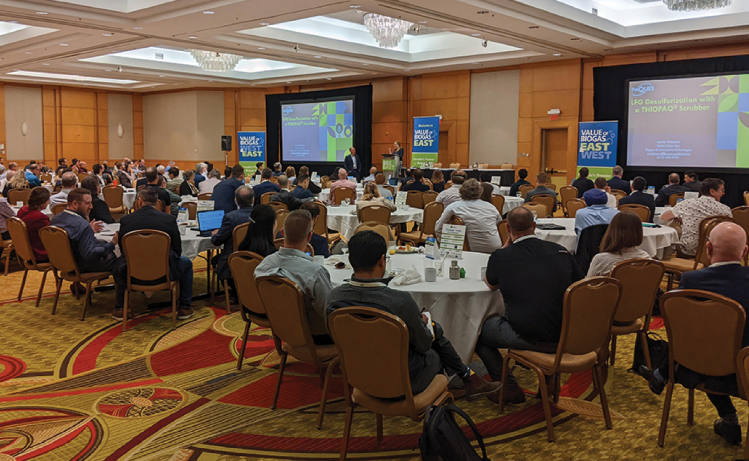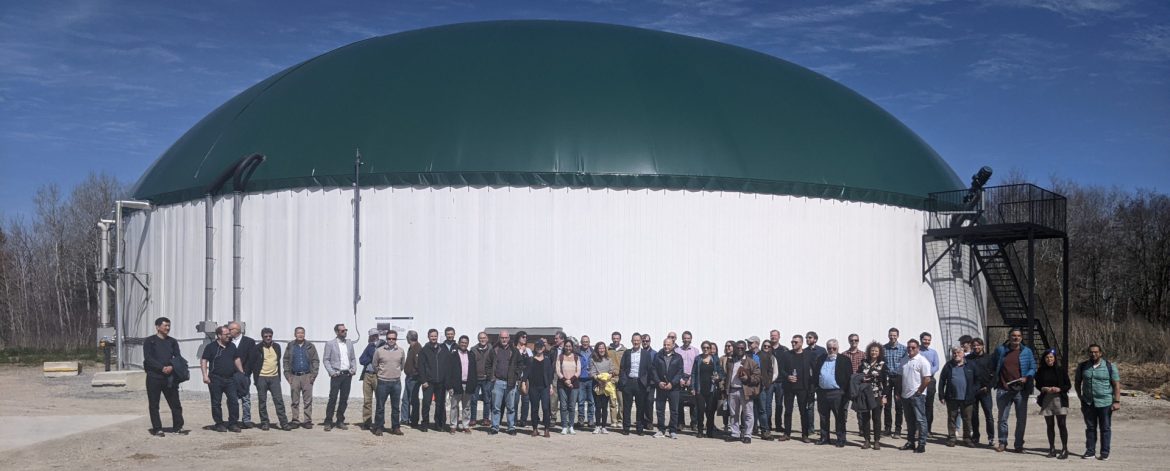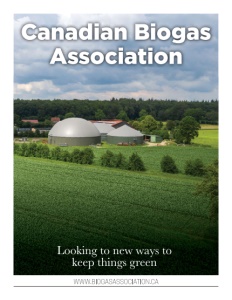Canadian Biogas Association
Looking to new ways to keep things green
The Canadian Biogas Association (CBA) represents over 175 members of Canada’s biogas and renewable natural gas (RNG) industry. Its membership covers agriculture and municipal production, the technology and expertise that help design, build and advise development of the facilities , and the demand by utilities seeking greener fuel sources, along with other stakeholders committed to helping the country achieve net zero.
Jennifer Green, Executive Director at CBA, explains the association’s background and mandate.

Jennifer Green, Executive Director, Canadian Biogas Association
“The Canadian Biogas Association supports the growth of biogas and renewable natural gas development in Canada,” she says.
“As the industry has grown in the last decade, the association continues as the voice of all stakeholders in the sector’s value chain.”
CBA’s member companies represent biogas & RNG developments within the agricultural sector covering farms, agribusinesses, and food processors. It also caters to the municipal industry covering landfill gas collection and dedicated anaerobic digestion facilities processing green bin material and merchant facilities processing food waste.
Besides the producer side of the association’s membership, several member companies provide expertise in services, specifically design, feasibility, and product and equipment-related support.
“Another unique element in our membership are entities seeking green energy opportunities, specifically gas utilities and others interested in net zero or sustainability targets as part of their corporate goals,” adds Green.
“Gas utilities are especially interested in how they can start decarbonizing their gaseous fuel and natural gas dependencies with renewable natural gas.”
The association’s Mandate
In fulfilling its mandate of helping the biogas industry in Canada grow, the CBA employs a four-pronged approach: advocacy, education and awareness, research, and knowledge transfer.
“The first leg of the stool is advocacy,” Green explains.
“We communicate with government departments provincially and federally to ensure that various policies, programs, and regulations in development or those that exist reflect a pathway biogas and renewable natural gas can take to gain mainstream adoption.”
“The second approach is education and awareness through initiatives and resources we launch and publish yearly. For example, we have a Canadian Anaerobic Digestion Guideline that sets out best practices and are currently developing a Canadian Digestate Management Guide addressing the value of the byproduct of these energy systems as a soil amendment or renewable fertilizer.”
“The third is research like a recent study we did called ‘Hitting Canada’s Climate Targets with Biogas and RNG.’ These resources specifically look at how biogas & RNG can position itself as a path to net zero, which has become a huge focus for us as a society in terms of contributing to our national and global climate goals.”
CBA’s fourth approach is supporting initiatives that enable knowledge transfer in the industry, including events, publications, partnerships, and other communication channels.
“One targeted initiative we did a year or so ago is Farming Biogas, which you can find at farmingbiogas.ca. It is a hub for agricultural producers wondering if biogas is a good fit for their business and what the opportunity means. The website answers these and other queries through factsheets, checklists, and other helpful tools.”
“We’re also developing other resources on our website tailored to the municipal audiences, like co-authoring a municipal guide for renewable natural gas. It addresses issues decision-makers, councilors, politicians, and bureaucrats want to understand in terms of how biogas can work for their municipality.”
Events and Promotions at the heart of the association
Besides these efforts, the CBA also hosts two annual Value of Biogas Conferences, one in the spring and another in the fall, focusing on providing information and networking opportunities to its members and other industry stakeholders.
“These are premier events where we showcase a lot of what’s happening within the industry,” Green says. “We share much current information through the speakers, presentations, and shared materials, and also through the networking that happens when you have a consolidated space where people can connect business-to-business and discuss the lay of the land.”
“Our events are an excellent time for people to come together and share the successes and learnings that have happened already and what might happen within the next six months.”

The CBA hosts high quality conferences and networking events.
Industry trends
The biogas & RNG market is growing rapidly. However, as with any nascent industry, there are bound to be teething problems, some of which Green says have more to do with legacy issues like policy and legal frameworks.
“Besides Canada, the United States and other countries are also experiencing challenges associated with ramping up this technology,” she says.
“Some of those challenges are partly due to limited, targeted policies overshadowed by other priorities like electrification or hydrogen fuels, including competing interests within the clean energy space.”
The other challenge the industry faces, Green says, is a lack of clear understanding of how the technology works and interfaces with other aspects of the economy.
“One of the incredible things about biogas is that it is a multifaceted energy enabler connecting waste management, emissions reductions, and the production of clean fuels for the future,” she says.
These options, though exciting, can be overwhelming to someone new to the industry, which is why Green says the CBA is working to ensure the correct information pathways are developed, so people understand biogas within given situations.
“We have to package the information based on elements like scale, population, application, infrastructure, and so on, so it’s easy for decision-makers to understand how biogas fits into their plans.”
Labor aspects
Skilled labor is another area that can impact the biogas industry’s growth. With multiple sectors competing for the same labor pool, the CBA is exploring different avenues to generate interest in the industry from the younger generation of skilled workers.
“Some trades are merging from traditional trades to the renewable field,” says Green. “As this happens, some workers are turning their attention to biogas & RNG. This interest is also trickling into learning institutions looking towards bodies like the CBA to get additional content for their curricula to communicate the finer details about the industry.”
Other areas in the biogas & RNG industry that might benefit from the traditional trades are instrumentation, electrical, mechanical, and biological systems, all of which can be staffed with tradespeople from conventional sectors.
Cost and Adoption considerations
Emerging renewable energy sources often must meet and overcome market forces to gain mainstream adoption, with the main challenge being cost.
Solar did this over a decade, with the cost of installing solar falling from $8.50 per watt in 2009 to $2.77 in 2022, a sixty-seven percent price decline.
Green admits this is a significant hurdle the biogas industry must scale, even though it isn’t the largest.
“At this point in the industry’s timeline, it’s still early days, so the technology does not come cheap,” she says.
“When you build a biogas plant, not only are you fronting all the investment for the components and infrastructure that you’re building, but the asset will live on for ten, twenty, possibly 30 years, depending on all the components that you would need to replace.”
To offset some of these costs, various government programs are offering to support the production of green energy.
“As interest in achieving emission reductions in Canada heightens, various government-sponsored programs are helping make green solutions more economical.”
“Another critical driver is the more progressive regions and businesses that have created programs that specifically allow fixed price long term engagements with developers and producers, offering a monetary value that can help support the long-term longevity of plants.”
While Green admits that the cost of biogas & RNG is higher than traditional gas, she also points out that when considering other factors, this price disparity diminishes.
“As we layer in different elements like carbon pricing and the escalation factors that we’re seeing, the price delta is diminishing,” she says.
“Although biogas isn’t yet at par, as we look into the future, biogas & RNG can be a very compelling case, especially in long-haul transportation where significant savings can be realized when used as a displacement for diesel specifically.”
Looking Ahead
As the biogas industry forges ahead, the CBA plans to remain part of the Canadian biogas vanguard, helping chart a path into a prosperous future. However, it cannot achieve this in isolation from the world, which Green admits and points out that the association is actively interfacing with global biogas associations.
“From an environmental perspective, we are in this together as residents of this planet,” she says.
“No one solution is going to save us completely. However, biogas & RNG offers a suite of solutions that can provide energy for daily use from the waste we produce, and it’s an elegant solution that produces a lot of valuable byproducts.”
“I think it’s a fascinating industry, and there is so much opportunity that, if well positioned, can benefit every Canadian.”
“The CBA sees this tremendous potential and continues to work towards helping the industry take off in a big way.”
AT A GLANCE
Canadian Biogas Association
What: Association representing Canada’s biogas and renewable natural gas (RNG) industry
Where: Ottawa, Canada
Website: https://biogasassociation.ca/


